The Man And His Machine
I Remember
The Saharan storm intensifies, ochre-colored sand blasting against my faceplate in stinging waves. Though this is technically Earth—the Moroccan desert's Mars Analog Testing Site—the 47°C heat and near-zero visibility create a convincing simulation of Martian dust storms, minus the radiation and extreme cold. My training suit's cooling system, now compromised by fine particles clogging critical intake valves, blares warnings across my HUD: "INTERNAL TEMPERATURE: 39.2°C—CRITICAL FAILURE IMMINENT."
I collapse onto the scorching sand, my vision narrowing as heat exhaustion takes hold. The training scenario has transformed into a genuine emergency; my locator beacon activates automatically as life-support systems begin shutting down to preserve core functions. Cardiac monitors detect my racing heartbeat—142 BPM and climbing.
Through wavering consciousness, I detect movement—a quadrupedal silhouette materializing through the billowing sandstorm. COBOT, my personally assigned AI companion, navigates directly toward me across the dune field. Unlike standard-issue robotic assistants, COBOT contains a neural network specifically trained on my behavioral patterns, medical history, and psychological profile.
The 78-kilogram robot approaches with measured steps, its articulated legs distributing weight evenly across the unstable surface. Its primary sensor array instantly analyzes my physiological state, transmitting real-time data to the medical team 7 kilometers away at base camp. COBOT's external compartment opens, revealing emergency hydration supplies and cooling packs.
As consciousness fades, I reach toward my mechanical savior—the culmination of decades of robotics research and my constant companion through sixteen months of rigorous Mars mission training. This desert emergency will become part of our shared operational data, strengthening the neural bond between human and machine before we attempt the actual 203-million-kilometer journey to the red planet. In this moment of vulnerability, I recognize the profound trust we've placed in our mechanical counterparts for humanity's greatest expedition.
COBOT in the Saharan storm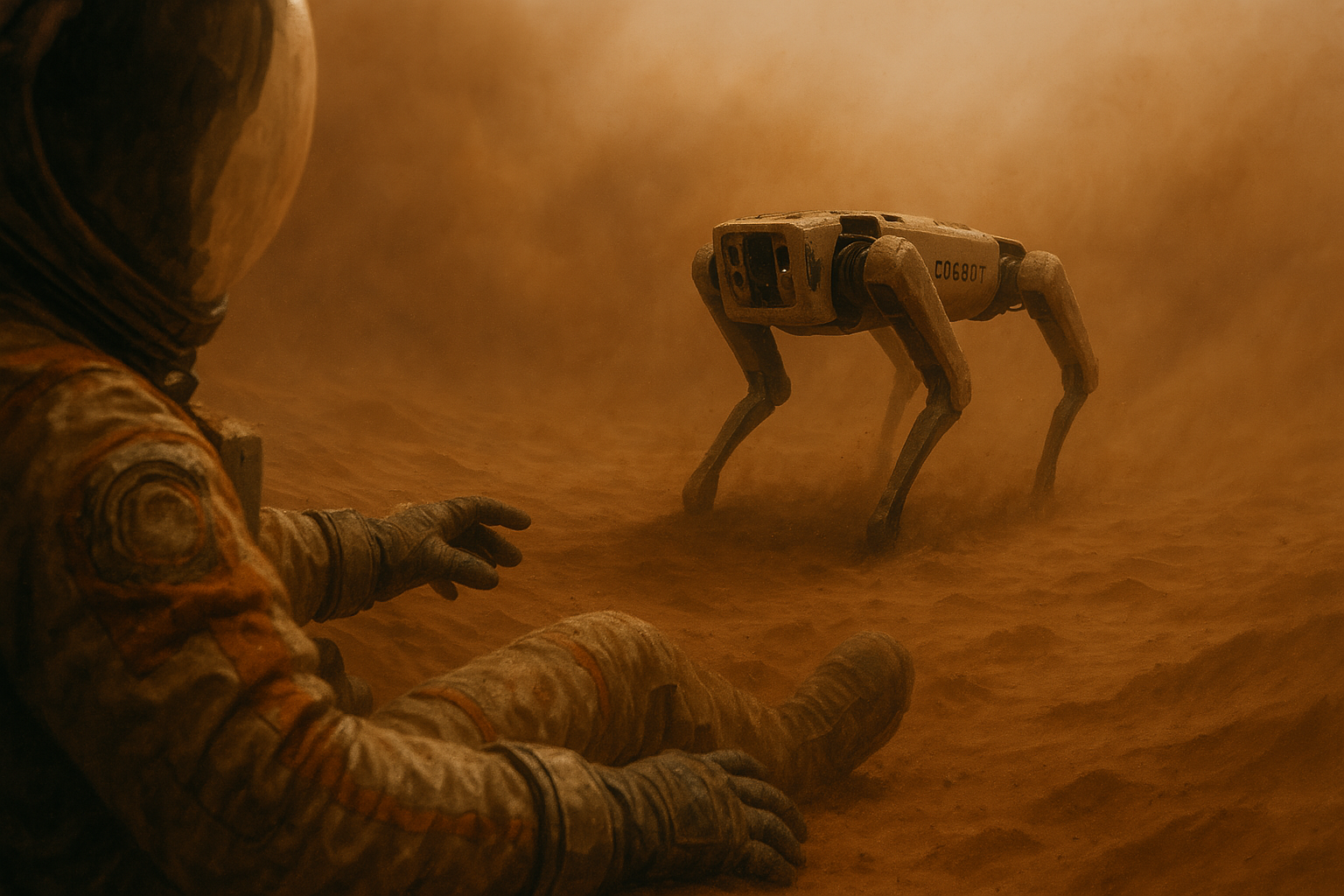
Transition to Moon Shot
The days following my desert rescue became a blur of medical evaluations and mission reassessments. After proving my resilience and completing the remaining Earth-based trials, our team was cleared for the lunar phase of training. Three months later, after the thundering ascent through Earth's atmosphere aboard Artemis VII, I found myself standing on the lunar surface—the first crucial stepping stone toward our ultimate Martian destination. The Moon would serve as our final proving ground, testing both human adaptability and machine reliability in the unforgiving vacuum of space before committing to the years-long Mars mission.
Moon Shot
Through the curved visor of my helmet, the universe unfolds in stark contrasts. I sit perched at the precipice of Shackleton Crater, my legs dangling freely 4.2 kilometers above the shadowed abyss below. The regolith—fine as talcum powder yet sharp as glass shards—clings to my thermal outer garments. Each small kick sends microscopic lunar dust floating in slow-motion, defying Earth's familiar physics with its 1/6 gravity ballet.
Earth hangs suspended in the absolute blackness—a luminous sapphire and emerald marble wrapped in swirling white clouds. Africa and parts of Europe are clearly visible beneath weather systems, the Mediterranean a blue vein against the Sahara's orange-brown expanse. Nothing prepares you for this perspective—3,84,400 kilometers of emptiness between myself and 7.8 billion souls who have never witnessed their planetary home from this vantage point.
The silence here is absolute. No air means no sound propagation, only the rhythmic hiss of my life support system and occasional crackle of comms. The temperature extremes are equally dramatic—the sunlit surface beneath me bakes at 123°C while shadows plunge to -233°C, a deadly 356-degree difference separated by mere centimeters.
I wiggle my boots against the cosmic void, watching dust particles drift rather than fall, feeling simultaneously infinitesimal and cosmically significant. This is humanity's ultimate precipice—sitting on the edge of an alien world, staring back at our collective home.
View of Earth from the Moon
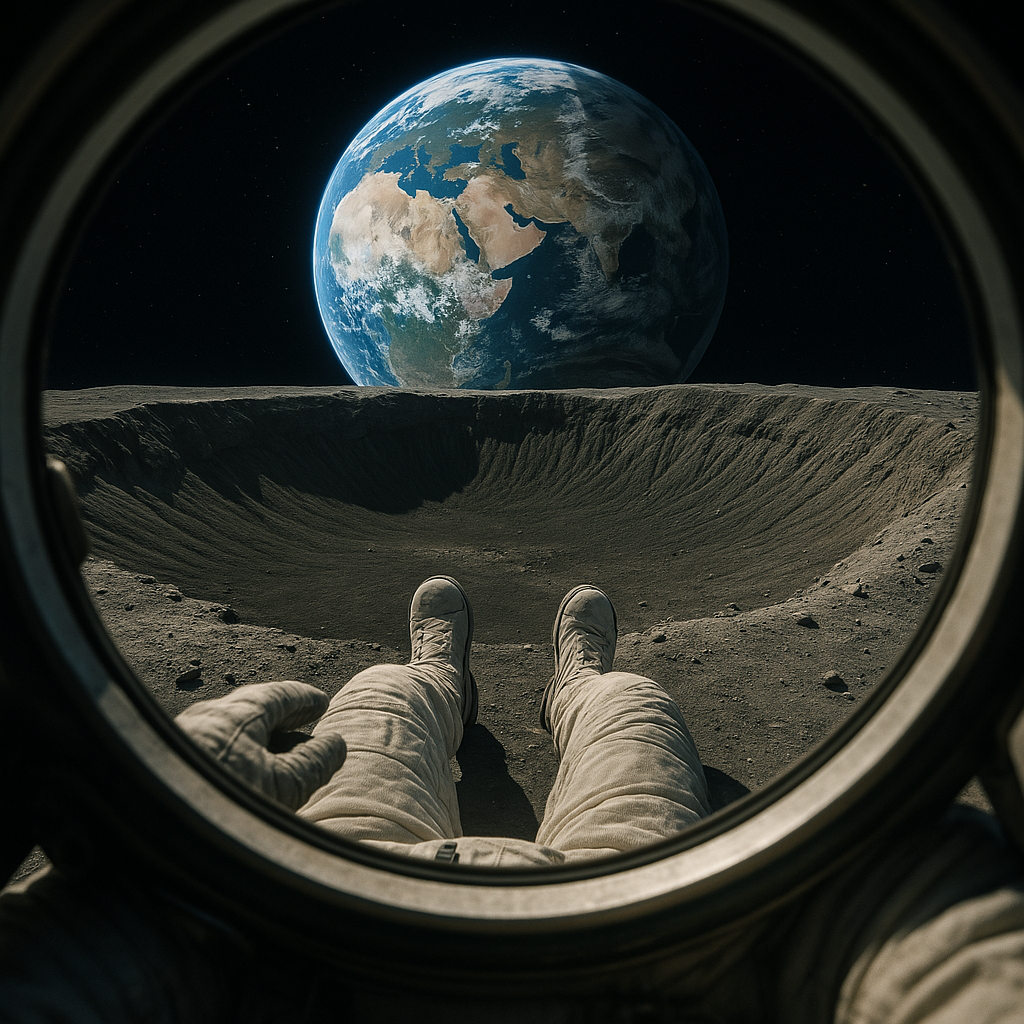
Transition to The Ride
The lunar phase of our training lasted eleven weeks—each day building our confidence in extraterrestrial operations and fine-tuning the symbiotic relationship between astronauts and our mechanical companions. COBOT and other specialized robots demonstrated exceptional adaptability to the lunar environment, validating decades of engineering and artificial intelligence development.
When the time came to depart, I took one final look at Earth hanging in the blackness before boarding the ascent vehicle. Six months of interplanetary travel followed—our crew of eight humans and twelve specialized robots suspended in the void between worlds. The journey itself became a crucible, forging our team into something more than the sum of its biological and mechanical parts.
The landing on Mars came with its own terror and beauty—the infamous "seven minutes of terror" during descent giving way to the surreal reality of standing on the red planet. Within days of establishing our base camp, it was time to test our mobility systems on actual Martian terrain.
The Ride
The Martian landscape blurs past at 47 kilometers per hour as I grip the controls of the Hermes X-2 Rover—NASA's latest two-wheeled ATV designed specifically for Mars' low gravity and unforgiving terrain. Through my visor, the horizon tilts as I navigate the ridge line of Acidalia Planitia, the vehicle's specialized carbon-fiber wheels biting into the iron-rich regolith, sending plumes of fine rust-colored dust erupting on both sides.
The rover's electric engine emits only a high-pitched whine that resonates through my suit, while the vibrations from countless embedded rocks transmit directly through the frame to my gloved hands. The specially designed suspension system absorbs most impacts, but larger obstacles send jarring shocks through my spine despite Mars' 0.38g gravitational pull.
My helmet's heads-up display tracks oxygen levels (87%), rover battery capacity (63%), and distance from habitat (12.8km). Temperature sensors register an external -62°C, though my environmental systems maintain a constant 21°C inside my suit. The late afternoon sun casts long shadows across ancient flood plains formed billions of years ago when water still flowed freely across this now-desiccated world.
Ahead lies Olympus Mons, rising 21km above the surrounding terrain—nearly three times the height of Mount Everest. The massive shield volcano dominates the northwestern horizon, an imposing reminder of Mars' geological power. I throttle forward, leaving twin tracks behind me that will remain undisturbed for centuries in this windswept, airless frontier.
Riding the Hermes X-2 Rover
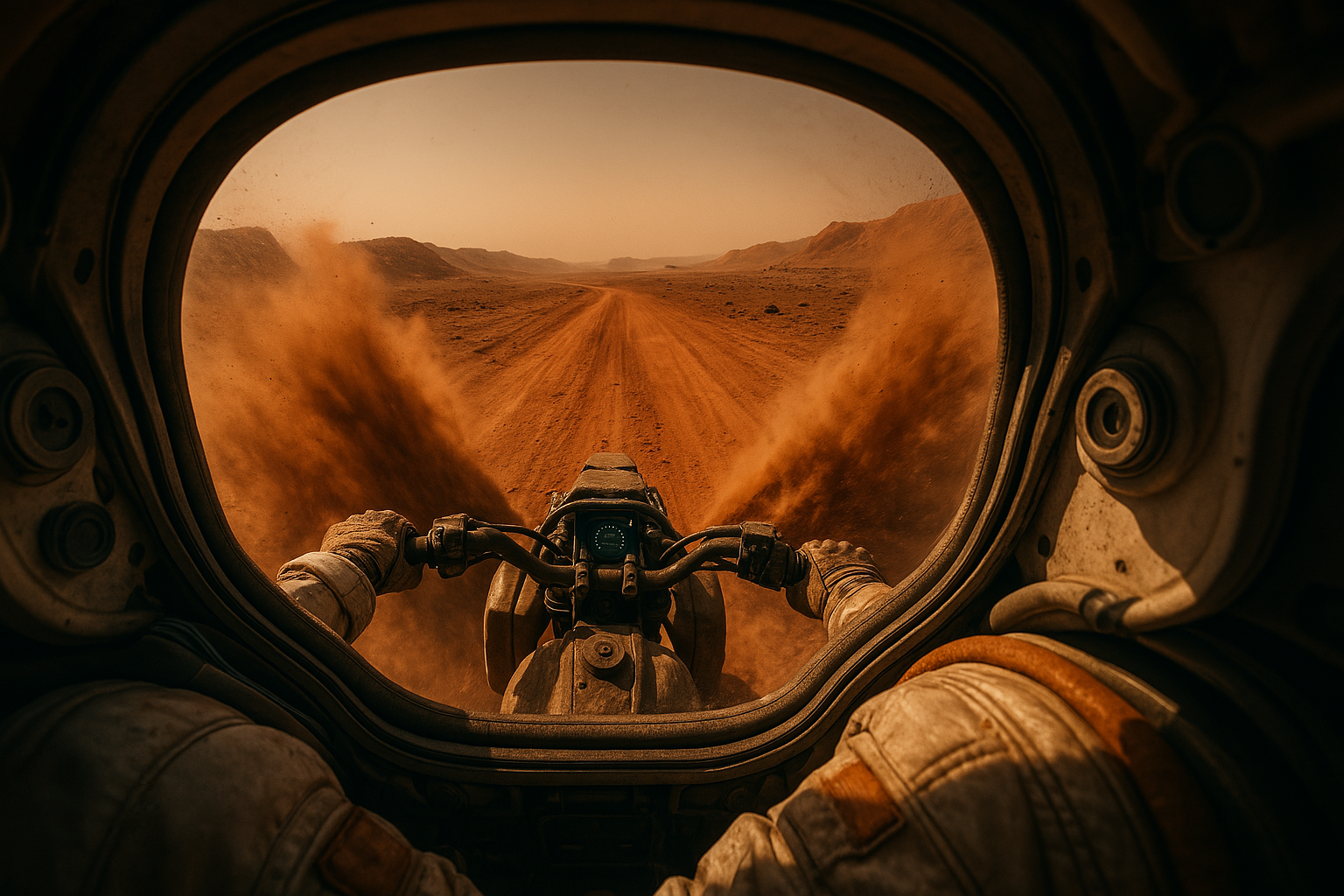
Transition to The Rover
The early exploration phase lasted three months, expanding our knowledge of the immediate territory surrounding the habitat. Each expedition ventured further, mapping potential research sites and cataloging geological formations. During the fourth month, a startling discovery appeared in our orbital surveys—what appeared to be the faint signature of a decades-old Earth mission, half-buried in the Martian regolith.
Historical records confirmed our suspicions: we had found the approximate location of Opportunity, one of the legendary early Mars rovers that had ceased communications in 2018 during a planet-wide dust storm. Mission Control granted permission for a recovery attempt, recognizing the historical significance and potential scientific value of retrieving Earth's pioneering explorer. With specialized equipment loaded onto my expedition vehicle, I departed our outpost for the treacherous journey through Eos Chasma.
The Rover
Pressed against the rough-hewn wall of Eos Chasma, I shelter from the intensifying Martian dust storm. Through my helmet's reinforced visor, visibility has decreased to less than 8 meters as rust-colored particles whip past at 96 kilometers per hour. The electrostatic discharge from dust particles colliding in Mars' thin atmosphere creates eerie, crackling patterns visible through the haze—making the air itself seem alive with energy.
Then, like a ghost materializing through the tempest, I spot it—Opportunity. The legendary rover sits motionless, its once-gleaming solar panels now caked with decades of accumulated dust. After 5,352 Martian sols of operation and 45.16 kilometers traveled, the little rover had finally succumbed to a similar storm in 2018, its final transmission to Earth a poignant: "My battery is low and it's getting dark."
Now, 15 years later, I've navigated through treacherous terrain to attempt what was once considered impossible—resurrection. In my equipment pack lies a specialized power unit and replacement communication module that could potentially revive this mechanical pioneer. Opportunity's six wheels remain partially buried in drift, its robotic arm frozen in mid-gesture like an archaeological artifact from humanity's first tentative expansion into the solar system.
The storm intensifies, pressure differential warnings flash across my HUD, but I've come too far to turn back. I check my tether anchoring me to the canyon wall and prepare to cross the final 20 meters separating me from one of the most successful exploratory missions in human history. Mission Control's voice crackles through my comms: "Proceed with extraction when ready. Bring our girl home."
Opportunity rover through the dust storm
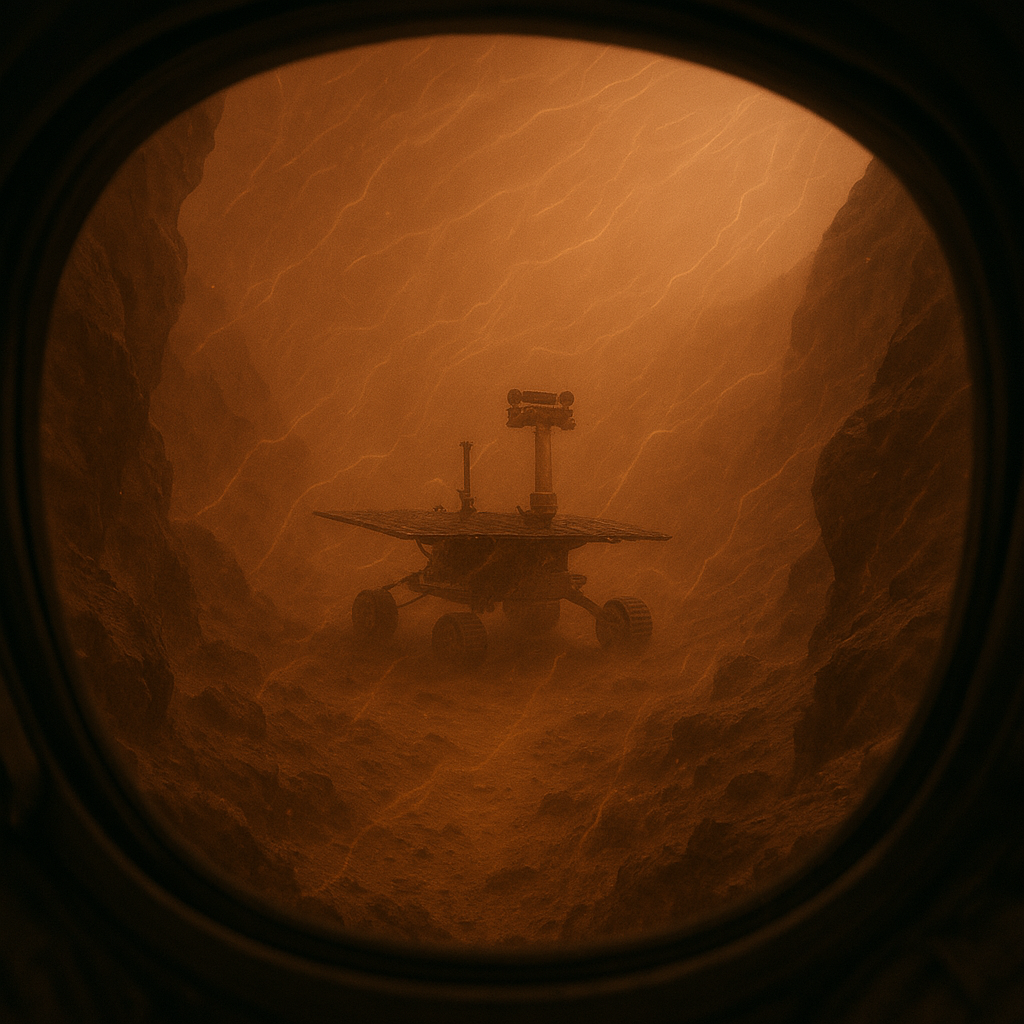
Transition to The Twist of Fate
The recovery mission was a bittersweet success. Though we managed to extract Opportunity and secure the rover for eventual return to Earth, the dust storm that had concealed its resting place grew into something far more dangerous. As I began the journey back to our habitat with the historic machine carefully stowed, the Martian atmosphere underwent one of its rare but catastrophic electrical events—a phenomenon only theorized until we witnessed it firsthand.
Base camp issued urgent warnings: the dust storm had developed into an unprecedented electrostatic event, with massive electrical discharges capable of damaging both equipment and personnel. With communication becoming increasingly erratic, I had no choice but to release my quadrupedal robotic companion from its transport bay to guide me through the intensifying electrical storm.
The Twist of Fate
The Martian electrostatic storm engulfs us without warning—a roiling tempest of charged particles creating a spectacular and lethal light show. Blue-white bolts of electricity, each carrying up to 10 million volts, spider-web across the copper-red sky only meters overhead. Each discharge superheats the surrounding atmosphere and vaporizes regolith on impact, sending columns of ionized dust spiraling upward in glowing orange tendrils.
My suit's external sensors detect dangerous electrical potential building across my outer shell—29,000 volts and climbing. In Earth's atmosphere, rubber insulation would provide protection; on Mars, with its 95% carbon dioxide atmosphere at 1/100th Earth's density, electricity follows unpredictable paths, seeking any conductor.
Dogbot Model KX-4, officially designated "COMPANION-217" but nicknamed "Sparky" by the crew; A Direct descendant of COBOT, bounds 3.2 meters ahead of me. Its quadrupedal titanium-alloy frame, designed specifically for Mars' varied terrain, navigates the uneven surface with algorithmic precision. Its 16 specialized sensors detect electrical anomalies invisible to human perception, plotting a safe trajectory through the storm's most dangerous sections.
The robot's forward-mounted xenon spotlight cuts through the haze, its polarized beam reducing glare from suspended particles. Sparky periodically pauses, scanning a 360-degree radius before emitting low-frequency pulses that disperse smaller electrical charges before they can coalesce into dangerous strikes. Its carbon nanotube outer shell serves as a protective Faraday cage—drawing potential strikes to itself rather than its human companion.
Mission protocols dictate shelter-in-place procedures during class 4 electrical events, but when our research habitat suffered catastrophic pressure loss, Sparky's advanced heuristic programming identified our best survival option: reaching Emergency Shelter Beta-6, now only 1.7 kilometers ahead through this otherworldly gauntlet.
Sparky leading through the electrical storm
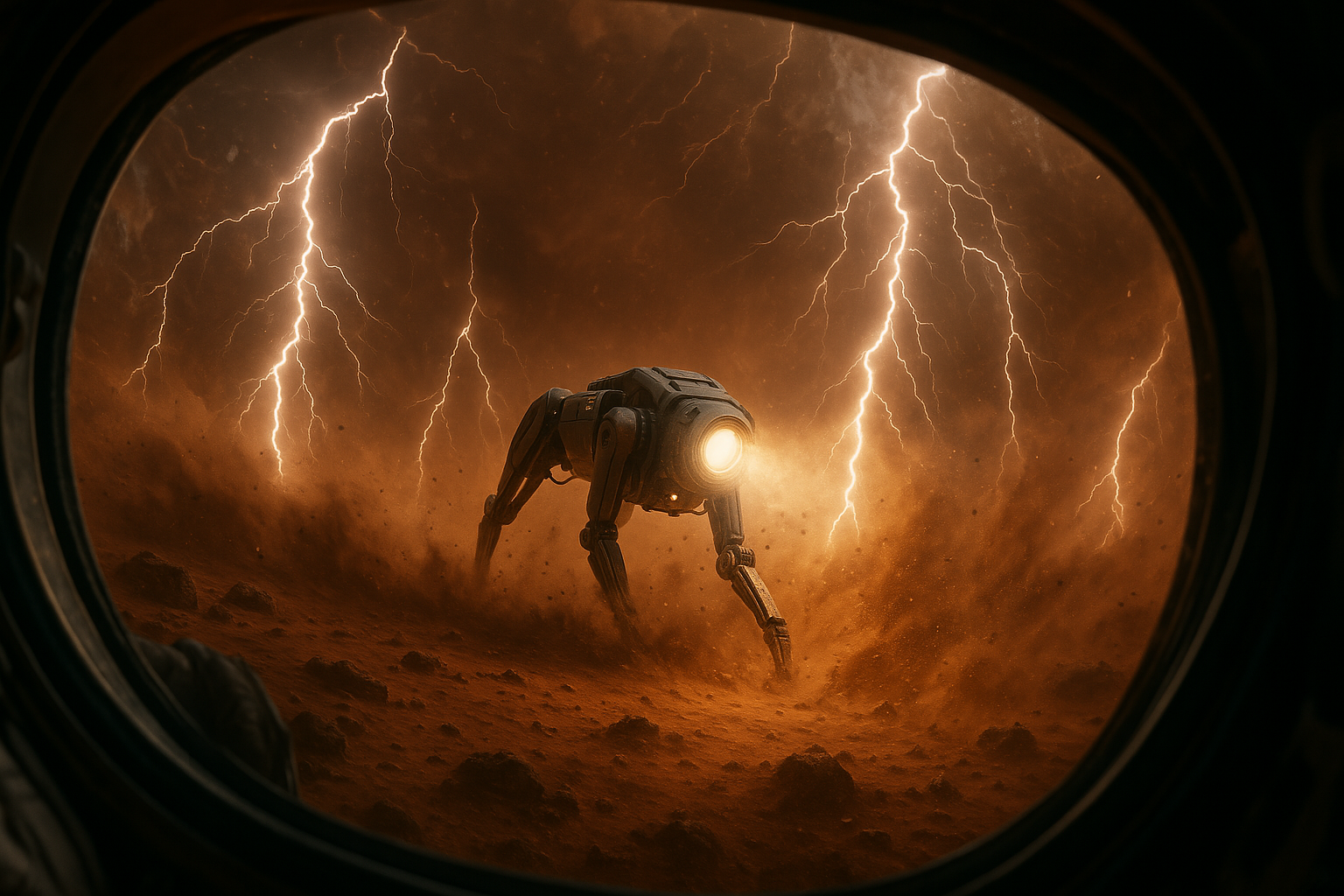
Epilogue
As I follow Sparky through the electric chaos of the Martian storm, I reflect on the journey that brought me here. From the scorching Saharan training grounds to the silent lunar crater, from the exhilarating ride across Acidalia Planitia to the recovery of a piece of human history, each step has deepened the connection between human explorer and mechanical companion.
What began as a programmed assistance relationship has evolved into something more profound—a partnership built on mutual dependence and shared experience. The machines that accompany us aren't merely tools but extensions of human curiosity and resilience, learning and adapting alongside us as we push the boundaries of exploration.
As Sparky pauses ahead, its sensors calculating our next safe passage through the storm, I understand that the future of space exploration will be written not just in human footprints but in the mechanical tracks that parallel our own—a shared journey of discovery across the cosmos.